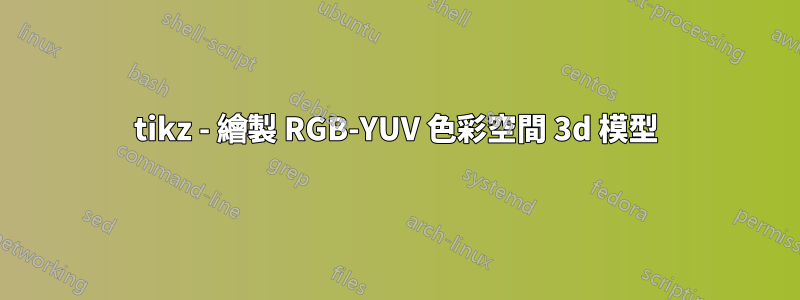
答案1
是的,有人可以教TikZ 進行線性變換。您的螢幕截圖顯示了非正交投影。所以我在答案的末尾添加了這樣的投影,儘管我個人不太喜歡它們。我添加了一個執行線性變換的函數RGBvec(模錯字,因為我不擅長從螢幕顯示中輸入文本,特別是當我不知道這些東西來自哪裡時),並添加了一個快速樣式,將 RGB 座標轉換為另一種配色方案。所有這些事情都可以調整,但這至少表明了原則上如何做到這一點。
\documentclass[tikz,border=3mm]{standalone}
\usepackage{tikz-3dplot}
\def\matCC{{0.257, 0.504, 0.098},%
{-0.148, -0.291, 0.439},%
{0.439, -0.368,0.071}}%
\pgfmathdeclarefunction{RGBvec}{3}{%
\begingroup%
\pgfmathsetmacro{\myY}{16+{\matCC}[0][0]*#1+{\matCC}[0][1]*#2+{\matCC}[0][2]*#3}%
\pgfmathsetmacro{\myCb}{128+{\matCC}[1][0]*#1+{\matCC}[1][1]*#2+{\matCC}[1][2]*#3}%
\pgfmathsetmacro{\myCr}{128+{\matCC}[2][0]*#1+{\matCC}[2][1]*#2+{\matCC}[2][2]*#3}%
\edef\pgfmathresult{\myCr,\myCb,\myY}%
\pgfmathsmuggle\pgfmathresult\endgroup%
}%
\begin{document}
\tdplotsetmaincoords{70}{110}
\begin{tikzpicture}[bullet/.style={circle,inner
sep=2pt,fill},line cap=round,line join=round,
RGB coordinate/.code args={(#1,#2,#3)}{\pgfmathparse{RGBvec(#1,#2,#3)}%
\tikzset{insert path={(\pgfmathresult)}}},font=\sffamily,thick]
\begin{scope}[tdplot_main_coords,scale=1/40]
\draw[-stealth] (0,0,0) coordinate (O) -- (280,0,0) coordinate[label=below:Cr] (Cr);
\draw[-stealth] (O) -- (0,280,0) coordinate[label=below:Cb] (Cb);
\draw[-stealth] (O) -- (0,0,280) coordinate[label=left:Y] (Y);
\path [RGB coordinate={(255,255,255)}] node[bullet,draw,fill=white] (white){}
[RGB coordinate={(0,0,0)}] node[bullet] (black){}
[RGB coordinate={(255,0,0)}] node[bullet,red] (red){}
[RGB coordinate={(0,255,0)}] node[bullet,green] (green){}
[RGB coordinate={(0,0,255)}] node[bullet,blue] (blue){}
[RGB coordinate={(255,0,255)}] node[bullet,magenta] (magenta){}
[RGB coordinate={(255,255,0)}] node[bullet,yellow] (yellow){}
[RGB coordinate={(0,255,255)}] node[bullet,cyan] (cyan){};
\draw (red) -- (black) -- (blue) -- (magenta) -- (red) -- (yellow)
-- (green) edge (black) -- (cyan) edge (blue) -- (white) edge (magenta) -- (yellow);
\draw[thin] (255,0,0) node[left]{255} -- (255,255,0) -- (0,255,0) node[above]{255}
(0,0,255) node[left]{255} -- (255,0,255) edge (255,0,0)
-- (255,255,255) edge (255,255,0) -- (0,255,255) edge (0,255,0)
-- cycle ;
\end{scope}
\begin{scope}[xshift=8cm,scale=1/40]
\pgfmathdeclarefunction*{RGBvec}{3}{%
\begingroup%
\pgfmathsetmacro{\myY}{16+{\matCC}[0][0]*#1+{\matCC}[0][1]*#2+{\matCC}[0][2]*#3}%
\pgfmathsetmacro{\myCb}{128+{\matCC}[1][0]*#1+{\matCC}[1][1]*#2+{\matCC}[1][2]*#3}%
\pgfmathsetmacro{\myCr}{128+{\matCC}[2][0]*#1+{\matCC}[2][1]*#2+{\matCC}[2][2]*#3}%
\edef\pgfmathresult{\myCb,\myY,\myCr}%
\pgfmathsmuggle\pgfmathresult\endgroup%
}%
\draw[-stealth] (0,0,0) coordinate (O) -- (255,0,0) coordinate[label=below:Cb] (Cb);
\draw[-stealth] (O) -- (0,255,0) coordinate[label=left:Y] (Y);
\draw[-stealth] (O) -- (0,0,255) coordinate[label=below:Cr] (Cr);
\path [RGB coordinate={(255,255,255)}] node[bullet,draw,fill=white] (white){}
[RGB coordinate={(0,0,0)}] node[bullet] (black){}
[RGB coordinate={(255,0,0)}] node[bullet,red] (red){}
[RGB coordinate={(0,255,0)}] node[bullet,green] (green){}
[RGB coordinate={(0,0,255)}] node[bullet,blue] (blue){}
[RGB coordinate={(255,0,255)}] node[bullet,magenta] (magenta){}
[RGB coordinate={(255,255,0)}] node[bullet,yellow] (yellow){}
[RGB coordinate={(0,255,255)}] node[bullet,cyan] (cyan){};
\draw (red) -- (black) -- (blue) -- (magenta) -- (red) -- (yellow)
-- (green) edge (black) -- (cyan) edge (blue) -- (white) edge (magenta) -- (yellow);
\end{scope}
\end{tikzpicture}
\end{document}
正交投影的優點是您可以應用正交變換,即旋轉,並且結果是真實的(直到透視效果,可以使用庫來處理perspective)。
\documentclass[tikz,border=3mm]{standalone}
\usepackage{tikz-3dplot}
\def\matCC{{0.257, 0.504, 0.098},%
{-0.148, -0.291, 0.439},%
{0.439, -0.368,0.071}}%
\pgfmathdeclarefunction{RGBvec}{3}{%
\begingroup%
\pgfmathsetmacro{\myY}{16+{\matCC}[0][0]*#1+{\matCC}[0][1]*#2+{\matCC}[0][2]*#3}%
\pgfmathsetmacro{\myCb}{128+{\matCC}[1][0]*#1+{\matCC}[1][1]*#2+{\matCC}[1][2]*#3}%
\pgfmathsetmacro{\myCr}{128+{\matCC}[2][0]*#1+{\matCC}[2][1]*#2+{\matCC}[2][2]*#3}%
\edef\pgfmathresult{\myCr,\myCb,\myY}%
\pgfmathsmuggle\pgfmathresult\endgroup%
}%
\tikzset{RGB coordinate/.code args={(#1,#2,#3)}{\pgfmathparse{RGBvec(#1,#2,#3)}%
\tikzset{insert path={(\pgfmathresult)}}}}
\begin{document}
\foreach \X in {0,10,...,350}
{\tdplotsetmaincoords{70}{\X}
\begin{tikzpicture}[bullet/.style={circle,inner
sep=2pt,fill},line cap=round,line join=round,font=\sffamily,thick]
\path[use as bounding box] (-5.5,-2) rectangle (5.5,8);
\begin{scope}[tdplot_main_coords,scale=1/40,shift={(-128,-128,0)}]
\draw[-stealth] (0,0,0) coordinate (O) -- (280,0,0) coordinate[label=below:Cr] (Cr);
\draw[-stealth] (O) -- (0,280,0) coordinate[label=below:Cb] (Cb);
\draw[-stealth] (O) -- (0,0,280) coordinate[label=left:Y] (Y);
\path [RGB coordinate={(255,255,255)}] node[bullet,draw,fill=white] (white){}
[RGB coordinate={(0,0,0)}] node[bullet] (black){}
[RGB coordinate={(255,0,0)}] node[bullet,red] (red){}
[RGB coordinate={(0,255,0)}] node[bullet,green] (green){}
[RGB coordinate={(0,0,255)}] node[bullet,blue] (blue){}
[RGB coordinate={(255,0,255)}] node[bullet,magenta] (magenta){}
[RGB coordinate={(255,255,0)}] node[bullet,yellow] (yellow){}
[RGB coordinate={(0,255,255)}] node[bullet,cyan] (cyan){};
\draw (red) -- (black) -- (blue) -- (magenta) -- (red) -- (yellow)
-- (green) edge (black) -- (cyan) edge (blue) -- (white) edge (magenta) -- (yellow);
\draw[thin] (255,255,0) -- (255,0,0) node[pos=1.1]{255}
(255,255,0) --(0,255,0) node[pos=1.1]{255}
(0,0,255) node[left]{255} -- (255,0,255) edge (255,0,0)
-- (255,255,255) edge (255,255,0) -- (0,255,255) edge (0,255,0)
-- cycle ;
\end{scope}
\end{tikzpicture}}
\end{document}
當然,可以使連接呈現顏色過渡。
\documentclass[tikz,border=3mm]{standalone}
\usepackage{tikz-3dplot}
\def\matCC{{0.257, 0.504, 0.098},%
{-0.148, -0.291, 0.439},%
{0.439, -0.368,0.071}}%
\pgfmathdeclarefunction{RGBvec}{3}{%
\begingroup%
\pgfmathsetmacro{\myY}{16+{\matCC}[0][0]*#1+{\matCC}[0][1]*#2+{\matCC}[0][2]*#3}%
\pgfmathsetmacro{\myCb}{128+{\matCC}[1][0]*#1+{\matCC}[1][1]*#2+{\matCC}[1][2]*#3}%
\pgfmathsetmacro{\myCr}{128+{\matCC}[2][0]*#1+{\matCC}[2][1]*#2+{\matCC}[2][2]*#3}%
\edef\pgfmathresult{\myCr,\myCb,\myY}%
\pgfmathsmuggle\pgfmathresult\endgroup%
}%
\tikzset{RGB coordinate/.code args={(#1,#2,#3)}{\pgfmathparse{RGBvec(#1,#2,#3)}%
\tikzset{insert path={(\pgfmathresult)}}}}
\begin{document}
\tdplotsetmaincoords{70}{110}
\begin{tikzpicture}[bullet/.style={circle,inner
sep=2pt,outer sep=0pt,fill},connection bar/.style args={(#1)--(#2)}{%
insert path={let \p1=(#1),\p2=(#2),\n1={atan2(\y2-\y1,\x2-\x1)} in
[left color=#1,right color=#2,shading angle=\n1+90]
(#1.\n1-25) arc(\n1-25:\n1+25:40*2pt)
-- (#2.\n1-180-25) arc(\n1-180-25:\n1-180+25:40*2pt) -- cycle}},
line cap=round,line join=round,font=\sffamily,thick]
\path[use as bounding box] (-5.5,-2) rectangle (5.5,8);
\begin{scope}[tdplot_main_coords,scale=1/40,shift={(-128,-128,0)}]
\draw[-stealth] (0,0,0) coordinate (O) -- (280,0,0) coordinate[label=below:Cr] (Cr);
\draw[-stealth] (O) -- (0,280,0) coordinate[label=below:Cb] (Cb);
\draw[-stealth] (O) -- (0,0,280) coordinate[label=left:Y] (Y);
\path [RGB coordinate={(255,255,255)}] node[bullet,draw,fill=white] (white){}
[RGB coordinate={(0,0,0)}] node[bullet] (black){}
[RGB coordinate={(255,0,0)}] node[bullet,red] (red){}
[RGB coordinate={(0,255,0)}] node[bullet,green] (green){}
[RGB coordinate={(0,0,255)}] node[bullet,blue] (blue){}
[RGB coordinate={(255,0,255)}] node[bullet,magenta] (magenta){}
[RGB coordinate={(255,255,0)}] node[bullet,yellow] (yellow){}
[RGB coordinate={(0,255,255)}] node[bullet,cyan] (cyan){};
\path[connection bar={(black)--(blue)}];
\path[connection bar={(blue)--(magenta)}];
\path[connection bar={(magenta)--(red)}];
\path[connection bar={(red)--(black)}];
\path[connection bar={(white)--(magenta)}];
\path[connection bar={(cyan)--(blue)}];
\path[connection bar={(green)--(black)}];
\path[connection bar={(yellow)--(red)}];
\path[connection bar={(yellow)--(green)}];
\path[connection bar={(green)--(cyan) }];
\path[connection bar={(cyan)--(white)}];
\path[connection bar={(white)--(yellow)}];
\draw[thin] (255,255,0) -- (255,0,0) node[pos=1.1]{255}
(255,255,0) --(0,255,0) node[pos=1.1]{255}
(0,0,255) node[left]{255} -- (255,0,255) edge (255,0,0)
-- (255,255,255) edge (255,255,0) -- (0,255,255) edge (0,255,0)
-- cycle ;
\end{scope}
\end{tikzpicture}
\end{document}
一些備註:
- 原則上,如果進行線性變換,有一個更簡單的方法:
\begin{scope}[x={(x)},y={(y)},x={(y)}] ... \end{scope}、其中(x)、(y)和(z)是基底向量。但隨著額外的轉變,事情變得有點混亂,我認為明確地擁有座標可能是有意義的。 \pgfshadecolortorgb允許在 RGB 座標中轉換顏色。寫這篇文章的時候,我並沒有考慮過要使用它。
答案2
一個起點。現在您可以在 3d 座標上繪圖。看了你的個人資料,我相信你可以做到。
\documentclass[tikz,margin=3]{standalone}
\usetikzlibrary{arrows.meta}
\begin{document}
\begin{tikzpicture}[z={(-135:.5)},>=Stealth]
\draw[thick,->] (0,0,0) -- (5,0,0) node[below] {Cb};
\draw[thick,->] (0,0,0) -- (0,5,0) node[left] {Y};
\draw[thick,->] (0,0,0) -- (0,0,5) node[below] {Cr};
\draw (4,0,0) node[anchor=135] {255} |- (0,4,0) node[anchor=-30] {255}
-- (0,4,4) |- (4,0,4) -- cycle
(0,4,4) -| (4,0,4) (4,4,4) -- (4,4,0)
(0,0,4) node[anchor=-30] {255};
\path (0,0) node[below] {0};
\end{tikzpicture}
\end{document}









